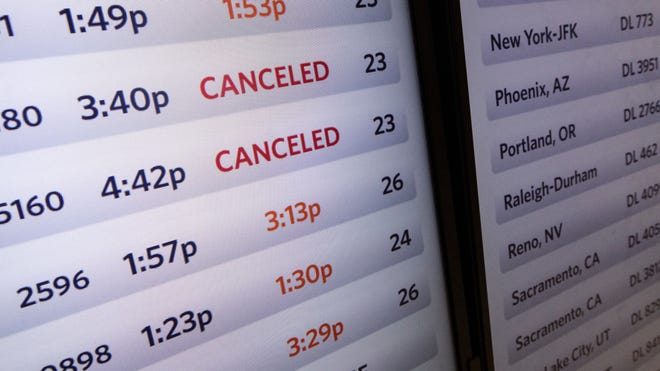- Planes are designed to withstand tremendous forces on their components when they’re flying.
- But there’s more to keeping flying safe than the structural capabilities of airplanes.
- The decision to delay or cancel a flight due to weather ultimately comes down to safety.
Sometimes, I’ll be on a flight going through a patch of turbulence and think to myself: “OK, this is unpleasant, but I know I’m safe.”
Planes are designed to withstand tough weather conditions, which brings the question: Why do weather delays happen?
It turns out there’s a lot going on behind the scenes of weather disruptions.
“Airplanes themselves are very capable,” Ken Byrnes, assistant dean and chairman of flight training at Embry-Riddle Aeronautical University, told me. “When you look at how these aircraft are designed, they’re designed to withstand tremendous loads.”
Airplanes can structurally handle much more than Mother Nature is ever likely to throw at them, but that’s just one aspect of the “go” or “no-go” decision for a flight.
All flyers know weather is often enemy No. 1 of a smooth travel day. Here’s why.

Planes can withstand the weather
Next time you’re flying through turbulence, look out the window at the wing. You’ll notice it flexing. It’s supposed to do that. The flex actually helps the plane stay more stable in rough air and means the wing is absorbing and dissipating the forces it’s encountering safely.
As Byrnes said, planes are designed to withstand tremendous forces on their components when they’re flying. All parts of an airplane’s structure are tested to make sure they can stay intact even in severe conditions.
“A lot goes into reducing the risk through the design capability,” he told me.
In testing, airplane wings will be flexed way beyond their regular inflight limits.
Similarly, airplane engines are designed to withstand natural obstacles like hail, torrential rain and bird strikes within certain limits.
Why bad weather can make flying dangerous anyway
There’s more to keeping flying safe than the structural capabilities of airplanes, however.
“They may be physically capable to withstand the loads, but the aerodynamic pressures that may occur within storms may make it very difficult to continue to fly,” Byrnes said. “There are a couple of things you want to avoid, first would be windshear, any changes in wind or directions.” Rapidly shifty or changing wind conditions can affect the aerodynamic characteristics of the plane and could result in a loss of lift.
“We want to avoid those more turbulent conditions. They can cause an airplane to stall,” Byrnes said. “At a high altitude that is more forgiving. At a low altitude, that is very unforgiving. There’s no room to recover.”
That’s part of why bad weather is especially difficult on airport operations.
Incoming suboptimal weather conditions can often be avoided by changing the flight plan, but at an airfield, a storm is virtually impossible for arriving and departing aircraft to avoid.
“In that condition, it’s more important to ensure that you have enough lift to stay aloft,” Byrnes said. “The closer you are to ground, the less altitude you have to recover.”

It’s all about safety
As with pretty much everything in aviation, the decision to delay or cancel a flight because of weather ultimately comes down to safety.
“The goal of the airline is to provide the highest level of customer service, but at the utmost safety,” Byrnes said. “They’re not going to take risks that are unnecessary in order to meet that demand because it’s just not worth it.”
An airplane’s flight capabilities aren’t the only safety consideration, either. We’ve seen time and again recently that passengers these days are pretty bad at obeying the seat belt sign. Though an airplane may be designed to withstand severe turbulence, the human body is not if it’s not strapped in, so rough weather can present a danger to the people inside the cabin even if the aircraft itself is perfectly safe from an engineering standpoint.
Laura Einsetler, a captain at a major U.S. airline and author of the Captain Laura blog, told me that flight crews will never intentionally fly through severe weather, but sometimes they have no choice but to go through more moderate turbulence.
If that happens, she said, she’ll do everything she can to prepare her passengers for the bumps, but it ultimately comes down to each person to keep the cabin safe for everyone.
“Unfortunately, we’ve flown enough we make the announcement and nobody listens,” she said. “It’s important for passengers to observe what the flight attendants are doing and saying in addition to the PA announcements we’re making to keep themselves safe at all times.”
Last week’s Cruising Altitude:Now is a great and cheap time to fly, even if airlines aren’t perfect.
The domino effect of weather on flying
Delays from bad weather often have a compounding effect on flying. A single delayed flight puts the plane and its crew out of sync with the airline’s schedule and can cause headaches for air traffic control as flight plans get adjusted.
If something goes wrong with your travel plans, it’s important to keep in mind these two pointers from Byrnes:
- First, remember the airline is putting your safety first. As much as you may want to get going, the airline wants to get you to your destination safely and comfortably. You’d probably leave a negative social media comment if your next flight became an hourslong roller coaster through a storm.
- Second, stay patient and kind with airline employees. As frustrating as delays can be, you’re all in the experience together.
Zach Wichter is a travel reporter for USA TODAY based in New York. You can reach him at [email protected].
